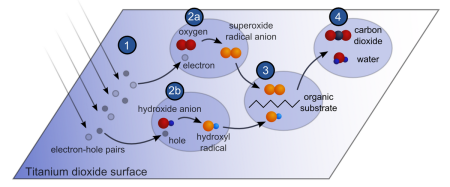Staff:
Branch focus:
Photocatalysis is a process applicable in environmental protection for the removal of pollutants, whether they are substances dissolved in wastewater (residues of drugs, dyes, hormones), substances dispersed in the air (NOx, aldehydes, aromatic substances, hydrocarbons), or substances that are in the solid phase (e.g. grease). The process of photocatalysis is associated with the irradiation of a titanium dioxide-based material (or other photocatalytic materials) with UV radiation, when radicals are photogenerated on the surface, which are capable of oxidatively degrading organic substances to harmless intermediate products. The use of photocatalysis can be divided into two basic areas:
- self-cleaning - thanks to the photocatalytic effect, the surface of the material is able to decompose solid organic impurities on the surface. The result is a surface resistant to dirt adhesion and thus maintains its original appearance and color for a long time
- cleaning of the surrounding environment - based on the ability of the activated material to oxidatively decompose specific undesirable substances present in polluted air or water. This makes it possible to suppress some adverse consequences of human activity, such as air pollution in densely populated areas.

Services offered:
We perform testing of photocatalytic activity according to standardized methods. The methods mentioned are part of the certification program of the Czech Society for Applied Photocatalysis. In addition, we develop new photocatalytic materials according to the specific requirements of industrial partners.
| Product | Feature | Norm |
| Coatings, concrete, ceramics, glass and other materials | air purification from NOx | ČSN ISO 22197-1 |
| air purification from VOCs – toluene | ČSN ISO 22197-3 | |
| air purification from VOC – acetaldehyde | ČSN ISO 22197-2 | |
| air purification from VOC – formaldehyde | ČSN ISO 22197-4 | |
| self-cleaning of the surface – degradation of methylene blue | ISO 10678:2010 | |
| surface self-cleaning (wetting) | ČSN ISO 27448 | |
| surface self-cleaning (resazurin reduction) | ISO 21066:2018 | |
| surface self-cleaning – degradation of rhodamine B | UNI 11259 | |
| antibacterial activity | ČSN ISO 27447 | |
| Air purifiers | Evaluation of the efficiency of the degradation of four VOCs (acetaldehyde, acetone, toluene, heptane (or hexane)). The initial concentration of each VOC is 1 ppm. Measurement of the released CO2. | ČSN EN 16846-1 |
Implemented projects:
- Photocatalytic foam ceramic panels (CZ.01.1.02/0.0/0.0/15_019/0004925)
- Photocatalytically active wallpapers (CZ.01.1.02/0.0/0.0/15_019/0004801)
- Ceiling modules for air purification with photocatalytic and antimicrobial function (CZ.01.1.02/0.0/0.0/21_374/0026732)
- Photocatalytic recovery unit (FW01010240)
- Composite photocatalysts based on TiO2 - activated carbon for water and air purification (LTACH17007)


